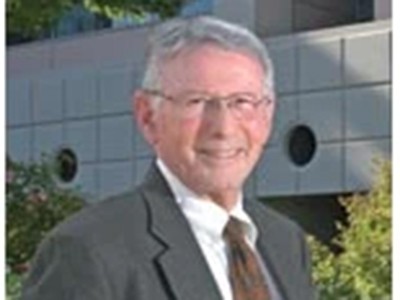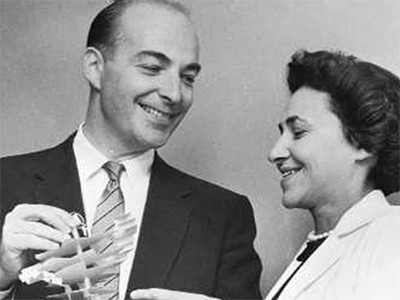
Credit: Sakuma/AP/Shutterstock
Paul Berg was the first researcher to incorporate DNA from one species into the genetic material of another. In so doing, he invented one of the most powerful tools in modern biology and the basis for a biotechnology industry that is worth hundreds of billions of dollars and has designed therapies for many human diseases. This alone would have been enough to establish Berg’s pre-eminent status — he received the Nobel Prize in Chemistry in 1980 — but he is also remembered for addressing anxieties about the possible risks of ‘recombinant’ research, and leading the development of a consensus on responsible use of the technology. He died on 15 February, aged 96.
Berg grew up and was educated in New York City and attended Abraham Lincoln High School in Brooklyn. This was the alma mater of another Nobel laureate, biochemist Arthur Kornberg, who later became a long-standing mentor to Berg. Berg’s undergraduate education in biochemistry at the Pennsylvania State University in University Park was interrupted by the outbreak of the Second World War, during which he served in the US Navy. To his disappointment, his passionate wish to become a naval pilot was never realized.
Berg went on to study biochemistry at what is now Case Western Reserve University in Cleveland, Ohio, in 1948. After a postdoc with biochemist Herman Kalckar in Copenhagen, Berg moved to the Department of Microbiology at Washington University in St. Louis, Missouri, to work with Kornberg. There, he gained international attention for reporting the role of a new intermediate molecule in the metabolism of fatty acids. Having gained faculty status, he went on to discover transfer RNA — first isolated by others in cell-free liver extracts — in extracts of Escherichia coli, and showed that amino acids are activated before being attached to transfer RNA for assembly into proteins.
In 1959, Berg relocated with Kornberg to Stanford University in California. Becoming interested in exploring gene function further, he spent a sabbatical year at the Salk Institute in San Diego, California, with virologist and cancer biologist Renato Dulbecco. This led Berg to retool his Stanford laboratory to work with animal cells that serve as hosts for polyoma viruses, such as the potentially cancer-causing DNA virus SV40. He pursued techniques that would allow him to study the expression of viral genes in prokaryotes such as E. coli, and the expression of prokaryotic genes in animal cells.
To do this, he devised a laborious and tricky strategy for generating DNA molecules that contain DNA from more than one species — recombinant DNAs. This involved using enzymes to snip open the circular genome of the SV40 virus and to snip out a fragment containing three genes from the DNA of the bacterium E. coli, then tailoring the free ends of both molecules so that they would rejoin as a single circle of DNA.
The idea was to use the modified SV40 as a viral vector to carry ‘foreign’ genetic material into animal cells. But soon after he initiated his experiments, concerns arose that introducing SV40 genes into E. coli and other common human intestinal bacteria could raise the risk of human cancer. This concern prompted Berg to call a moratorium on all recombinant DNA work in his laboratory until the issue could be explored more thoroughly.
As word spread about what Berg was attempting, elaborate theoretical catastrophic scenarios emerged, including the possible accidental generation of Frankenstein-like monsters — and even interference with natural evolution. Berg and his colleagues responded by convening two meetings at the Asilomar conference centre just south of San Francisco, California. The first, held in 1973, prompted Berg to circulate what became known as the Berg Letter to several journals, including Nature, requesting that members of the scientific community temporarily cease experiments involving recombinant DNA. The historic second meeting was held in 1975 to debate the pros and cons of recombinant DNA technology.
Conscious of the wide public interest, Berg and the other organizers made a point of inviting members of the press to the 1975 meeting, and encouraged them to ask questions, but requested they not file their reports until the conference had concluded. The conference participants agreed to a voluntary moratorium on research until guidelines could be promulgated for the safe use of the new technology. The US National Institutes of Health first published its guidelines in 1976, and these have been regularly updated ever since. As a result, the very real threat of a total ban on recombinant DNA research was averted, opening the door to genome sequencing and editing, and making possible countless advances in basic research, clinical medicine and drug discovery, and other applications of biotechnology.
Berg devoted huge amounts of time to promoting the safe use of recombinant DNA technology, which he went on to deploy towards clinical application. In 1980, with Kornberg and US geneticist Charles Yanofsky, he founded the DNAX Research Institute of Cellular and Molecular Biology in Palo Alto, California. He also served as the first director of Stanford’s multidisciplinary Beckman Center for Molecular and Genetic Medicine, opened in 1985.
Berg was an extraordinary scientist, teacher, mentor and administrator, and a skilled proponent of bringing good, old-fashioned common sense to bear on contentious public-policy issues, including later the use of embryonic stem cells in biomedical research. He formally closed his research laboratory at the turn of the twenty-first century, but continued to advise his department and his university, and to act as a consultant to biotechnology companies. The world of academia will sorely miss this giant of the early days of molecular biology and molecular genetics.



 An interview with Paul Berg
An interview with Paul Berg
 Asilomar 1975: DNA modification secured
Asilomar 1975: DNA modification secured
 Genetic manipulation: recommendations drafted
Genetic manipulation: recommendations drafted
 Adopt a moratorium on heritable genome editing
Adopt a moratorium on heritable genome editing
 Arthur Kornberg (1918–2007)
Arthur Kornberg (1918–2007)








